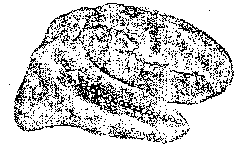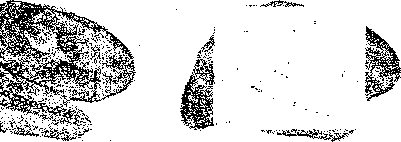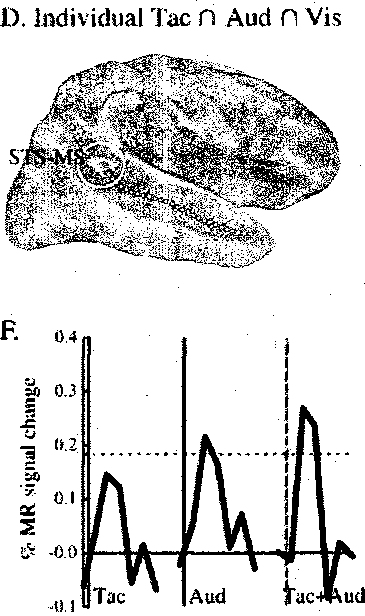56
A. Tactile
B. Auditory C. Visual



Figure 2. Responses to tactile, auditory and visual stimulation in Experiment 1. A. Lateral view of a
single subject's partially inflated right hemisphere. Colored regions responded significantly to tactile
stimulation. Active regions in posterior STS are colored yellow; other active regions are colored
purple. The fundus of the STS is shown as a white dashed line. B. Single subject activation to
auditory stimulation. C. Single subject activation to visual stimulation. D. Single subject conjunction
map showing voxels responding to all three modalities. Circled yellow cluster shows the STS
multisensory area, STSms. E Mixed effects group map (n=12). Voxels showing a significant response
to all three modalities. Yellow cluster shows the STSms, with center-of-mass (52,44,15). F. Single
subject MR time series from STSms. The dark black line shows the deconvolved event related
response in a 16.5-second window following stimulation onset for three kinds of trials, collapsed
across intensity of stimulation: Tac, tactile stimulation; Aud, auditory stimulation; Tac÷Aud, tactile
and auditory stimulation. The dashed line shows the mean unisensory response. The colored bars
show the 500 ms stimulus duration. G. Group average MR time series from STSms (n=12). The dark
black line shows the mean deconvolved event-related response, the gray line shows÷l SEM.

More intriguing information
1. The Effects of Reforming the Chinese Dual-Track Price System2. The name is absent
3. ENERGY-RELATED INPUT DEMAND BY CROP PRODUCERS
4. THE MEXICAN HOG INDUSTRY: MOVING BEYOND 2003
5. Spatial Aggregation and Weather Risk Management
6. The name is absent
7. Locke's theory of perception
8. Une nouvelle vision de l'économie (The knowledge society: a new approach of the economy)
9. Literary criticism as such can perhaps be called the art of rereading.
10. A Brief Introduction to the Guidance Theory of Representation